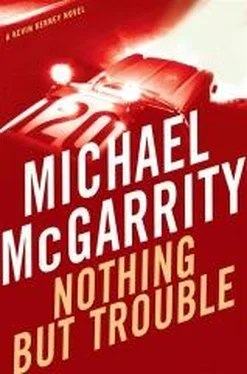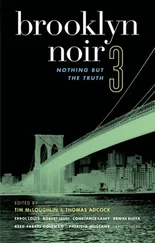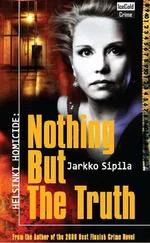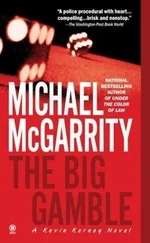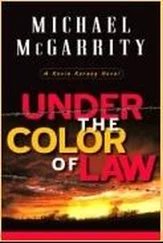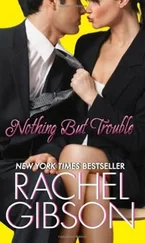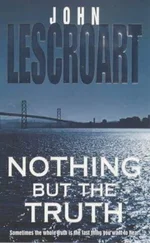Michael McGarrity - Nothing But Trouble
Здесь есть возможность читать онлайн «Michael McGarrity - Nothing But Trouble» весь текст электронной книги совершенно бесплатно (целиком полную версию без сокращений). В некоторых случаях можно слушать аудио, скачать через торрент в формате fb2 и присутствует краткое содержание. Жанр: Триллер, на английском языке. Описание произведения, (предисловие) а так же отзывы посетителей доступны на портале библиотеки ЛибКат.
- Название:Nothing But Trouble
- Автор:
- Жанр:
- Год:неизвестен
- ISBN:нет данных
- Рейтинг книги:4 / 5. Голосов: 1
-
Избранное:Добавить в избранное
- Отзывы:
-
Ваша оценка:
- 80
- 1
- 2
- 3
- 4
- 5
Nothing But Trouble: краткое содержание, описание и аннотация
Предлагаем к чтению аннотацию, описание, краткое содержание или предисловие (зависит от того, что написал сам автор книги «Nothing But Trouble»). Если вы не нашли необходимую информацию о книге — напишите в комментариях, мы постараемся отыскать её.
Nothing But Trouble — читать онлайн бесплатно полную книгу (весь текст) целиком
Ниже представлен текст книги, разбитый по страницам. Система сохранения места последней прочитанной страницы, позволяет с удобством читать онлайн бесплатно книгу «Nothing But Trouble», без необходимости каждый раз заново искать на чём Вы остановились. Поставьте закладку, и сможете в любой момент перейти на страницу, на которой закончили чтение.
Интервал:
Закладка:
“It’s kind of you to offer,” Kerney said, “but we’re due to get an early start in the morning to scout all the locations.”
“The first few stops are here on the ranch,” Julia said, “at the rodeo arena and then on the route Johnny’s picked for the cattle drive.”
She stepped close to Kerney, rubbed his arm, and smiled coquettishly. “I promise to kick you out of bed in time for you to make it to work.”
Kerney took Julia’s hand off his arm and patted it. “It’s a delightful invitation, but not a good idea, Julia. I’ll see you in the morning.”
She smiled to hide her disappointment, escorted Kerney to the front door, gave him a kiss on the cheek, and watched him walk to his truck. He cut a handsome figure in his jeans, long-sleeved cowboy shirt, boots, and hat. He was six foot one, square shouldered, blue eyed, and had a cute, firm butt and the most absolutely beautiful hands she’d ever seen on a man.
Both her ex-husbands had been studs in bed, but totally amoral, charming alley cats. She wondered why it had taken her so long to learn the difference between men and boys. She’d hoped to find Kerney in an unhappy marriage and susceptible to the possibility of an affair that might lead to something more. But so far it didn’t look promising.
She waved as Kerney honked the horn and drove away, thinking that he’d be back for three weeks when the film started shooting. That would give her plenty of time to test Kerney’s matrimonial fidelity.
Chapter Four
Kerney arrived in the town of Playas ahead of schedule and used his spare time to take a look around. What he saw amazed him. Although he knew Playas was a virtually abandoned, modern company town, it was quite another matter to see it.
The two-lane road into town was paved, and just on the outskirts were two churches, baseball fields, a swimming pool, and a recreation center. The road looped around a grassy knoll dotted with trees that formed the gateway to the town, where a single-story apartment building with a covered portal faced the parklike setting.
Beyond the town a sweep of low hills rose up, rock strewn, barren, and steeply sloped. Backed against them the town looked out at a dry, glistening white lakebed in a broad valley that stretched to the Animas Mountains. The word for beaches in Spanish was playas, and the dry lakebed looked exactly like a pristine sandy shore without any water.
Playas was a bit of suburbia transplanted in the middle of the desert. A raven flew overhead and Kerney thought that from a bird’s-eye view, with its paved streets, Santa Fe-style houses, and modern commercial buildings, it could have passed for a bedroom community outside any major southwestern city. At ground level things didn’t look so normal. On street after street abandoned, weather-beaten houses with cracked stucco, warped garage doors, faded trim, and blank windows looked out on weed-infested front yards peppered with dead trees and shrubs.
A few occupied houses stood out here and there with grassy lawns and shade trees in full green color. Cars were parked in driveways, front doors were cluttered with children’s toys and bikes, and there were curtains in the windows. On a street at the top of a small rise the occupied houses were larger, lawns bigger, shade trees more numerous, and the views of the valley spectacular. Kerney figured it to be the neighborhood where the mining company honchos had once lived.
The commercial area of town contained buildings that had once served as a mercantile store, medical clinic, post office, bank, community center, and an indoor recreation complex. As a cop Kerney could see the endless possibilities for using Playas as an antiterrorism training center. It would serve perfectly for any number of training scenarios, such as massive house-to-house searches, SWAT-team helicopter incursions, bomb-squad disposal operations, hostage-negotiation situations, sniper training, and any number of high-risk police, fire, or medical emergencies. In many ways the town reminded him of a much larger version of Hogan’s Alley, a self-contained, fully functional village on the grounds of the FBI Academy at Quantico, Virginia, which was used to train agents in crime-scene scenarios.
He made a mental note to talk to his training lieutenant about getting sworn personnel enrolled in the program once it was fully operational. He stopped at a sleek, stepped-back stuccoed structure with multiple entrances and a flat roof, where several semitrailers were parked. A group of men were unloading construction materials. On the lawn in front of the building two workers were planting a large carved wooden sign that read:
TOWN OF COUNCIL ROCK MUNICIPAL OFFICES
Council Rock was the name of the fictional town in the screenplay, which meant that Playas was already being dressed up as a movie set.
Kerney approached the men who were installing the sign and asked where the production team was meeting. One of the men pointed across the way to the community center, which Kerney found to be locked. He looked through the glass doors. Two long folding tables sat pushed together in the middle of the hall, surrounded by chairs. There were plastic coffee cups, water bottles, soda cans, and documents on the table, but no one inside.
He hung around and watched a crew of men use portable scaffolding to attach new signs to the stepped-back building. Over the next twenty minutes they transformed three doorways into entrances to the Council Rock mayor’s office, municipal court, and police headquarters.
Four black full-size SUVs pulled up to the curb in front of the community center. A dozen people piled out of the vehicles and walked quickly to the community meeting hall entrance. Kerney spotted Johnny Jordan in the middle of the pack, talking animatedly to a tall man carrying a thick three-ring binder and wearing chinos, athletic shoes, and a brand-new straw cowboy hat perched on the back of his head. He tagged along and got close enough to hear the two men exchange heated words about some proposed script changes.
Inside the community center the debate continued as the group took their seats around the tables. Unobtrusively, Kerney stood by the door and watched.
“I want that damn copper smelter in the film as the location for the climax of the chase scene,” the tall man in the new cowboy hat said.
“The climax occurs at the rodeo arena,” Johnny said, looking agitated. “We agreed on that when we finalized the script.”
“We can change the damn script,” the tall man said, as he flipped through the pages of the binder. “For Chrissake, that’s what writers are for. I want the copper smelter for the climax. All that industrial stuff sitting in the middle of a desert is visually stunning. Plus, it makes a great juxtaposition between the cowboy culture and modern society.”
“The brawl at the rodeo arena is the climax,” Johnny shot back.
The tall man stared Johnny down. “Here’s the way I see it: We keep the script as it is right through the scene where the cops scatter the cattle with police helicopters and the rancher hightails it off BLM land through the mountain pass. But instead of having the cops bust them later in the day at the ranch rodeo, we keep the pursuit going to the smelter, where the cops find the cowboys gathering up the strays. We’ll have cowboys on horseback chasing cows in and out of the buildings, cops chasing cowboys on foot and with squad cars, and a brawl that ends in a standoff when the rancher decides to call it quits before anyone gets seriously hurt.”
The tall man turned to a man with glasses on his immediate left, who was studying papers on a clipboard. “Costwise, can we do this?”
“If we drop the rodeo scenes completely, we can.”
“I’ve got world-class champions signed on to this film, expecting to showcase their talents,” Johnny said.
Читать дальшеИнтервал:
Закладка:
Похожие книги на «Nothing But Trouble»
Представляем Вашему вниманию похожие книги на «Nothing But Trouble» списком для выбора. Мы отобрали схожую по названию и смыслу литературу в надежде предоставить читателям больше вариантов отыскать новые, интересные, ещё непрочитанные произведения.
Обсуждение, отзывы о книге «Nothing But Trouble» и просто собственные мнения читателей. Оставьте ваши комментарии, напишите, что Вы думаете о произведении, его смысле или главных героях. Укажите что конкретно понравилось, а что нет, и почему Вы так считаете.
